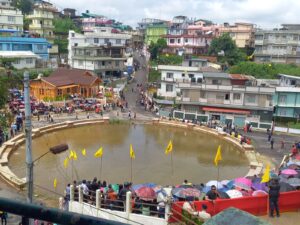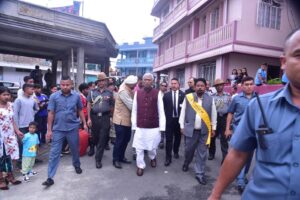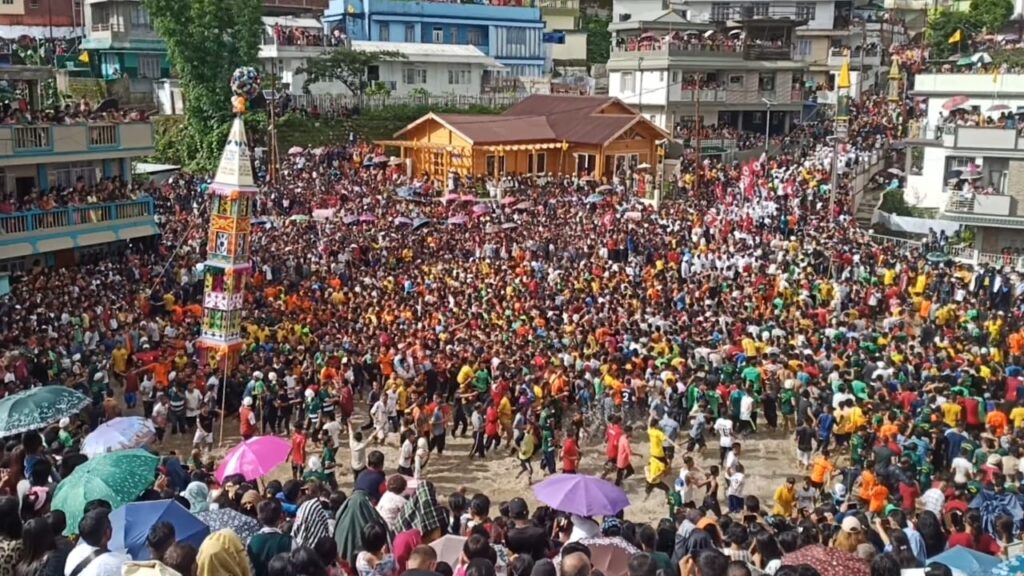Amidst the chanting of couplets and offering of prayers, the Behdieñkhlam festival came to a grand close on July 9 at the Aitnar sacred pool, located around 65 km from Shillong. This year, the festival was held from 6 to 9 July at various villages of Jaintia Hills but as tradition, the festival culminated on July 9 at the Aitnar sacred pool located in Jowai West Jaintia Hills.
The Behdieñkhlam festival of 2023 sent a message of love and respect towards all religions, beliefs and cultures. The festival, which originated as a way to drive away plague and evil spirits, is now a symbol of communal harmony with people from all faiths coming to witness the rituals and seek blessings.
The festival is observed by the Pnar community, but it has now become a global event with tourists from all over the world thronging to Jowai West Jaintia Hills to witness the unique religious ceremony.

Thousands of faithful from the Pnar community, including Governor of Meghalaya, Phagu Chauhan, witnessed the festivities on the concluding day of the festival. The festival saw thousands of faithful carrying monuments, called Rots, depicting various forms of evils in the society. These Rots were thrown away to symbolise chasing away all evils from the society, bringing back unity, peace, and prosperity to the people and the state as a whole.

Rituals and ceremonies of Behdieñkhlam
While trying to get a gist of how the Behdieñkhlam came into practice, O.R Challam, President of Seinraj Jowai, informed that according to the legend and oral information, the first Behdieñkhlam was celebrated when ‘U Dongsynriang was a Doloi’ and ‘U Het Langdoh was a Langdoh of Jowai. Challam emphasised that at present the plague does not only refer to this particular region but plagues exist in every society and in every individual like atrocity to women, drugs, corruptions not only in Meghalaya but all over the world.
Behdieñkhlam is made up of the three words, ‘Beh’ meaning to get rid of, ‘Dien’ meaning wood or log and ‘Khlam’ meaning plague and when taken together the word Behdieñkhlam means ‘to get rid of the plague.’
O.R Challam highlighted that the festival requires observance of a series of rites and rituals mostly executed by the traditional head under the supervision of U Doloi, U Langdoh, Ka Langdoh, U Pator, Ki Sangot wa ki Wasan Waheh of Ka Raij and the rituals are performed by every household under the consent of U Kni (uncle) and Ka Kchu (motherhood), which is known as Ka Niam Iong Iung.
The festival begins with the sacrifice of a pig to ‘Knia Pyrthat’, the god of thunder, followed by the collection of fallen tree trunks from the sacred forest. A priest or ‘wasan’ then rings a bell and walks to the sacred forest. Villagers then collect fallen tree trunks, leave them in the woods, then bring them back home with much fanfare. These trunks, known as ‘Khong,’ are erected in each locality and among homes.
Dance and sacrificial offerings in Behdieñkhlam
A vibrant part of this festival is the ‘raths’ or ‘rots,’ tall structures made of bamboo decorated with colored paper, tinsel, symbols, and messages that each village creates. A group of young men carry the rots to the ‘Aitnar’ or the sacred pool and throw them into the waters as an offering to the gods. A game similar to football using a wooden ball called ‘Dad-Lawakor’ is also played.

The festival is a way of showcasing the religious rituals of the Pnar community and keeping alive the culture and traditions of the people of the Niamtre belief.
Even this year, the Behdieñkhlam, though a religious culture or belief of the Pnar community, the festival saw hundreds of tourist from outside Meghalaya and other parts of the world came to catch a glimpse of this festival.
The concluding day of the festival saw thousands of faithful offering prayers for a bumper harvest and seeking blessings from their deities. Men took part in the dance in the Aitnar sacred pool, while women offered sacrificial food to the spirits of their forefathers.
The festival also included a symbolic killing of demons in a ritual called ‘Cher Iung Blai,’ where male members entered a thatched hut with spears and symbolically killed the demons inside it.
Apart from religious ceremonies and dances, men made a symbolic gesture of driving away the evil spirits, plague, and disease by beating the roof of every house with bamboo poles. The Behdieñkhlam festival is a celebration of the rich culture and traditions of Meghalaya, showcasing the spiritual beliefs and practices of the Pnar community.

